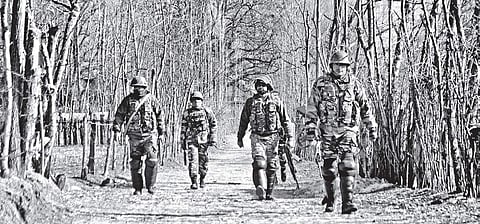

SRINAGAR: Winters in Kashmir are becoming warmer, and the ongoing 40-day period of the harshest cold, known as Chillai Kalan, has not been too severe. The weather during the day in Srinagar and other parts of the Valley remains pleasant and sunny and does not give the feel that Kashmir is in the grip of extreme cold.
A study done by Kashmir University’s Department of Earth Sciences a few years ago found that due to climate change, the average minimum and maximum temperatures in the Valley in the winter months were showing significant trends of increasing.
It found that precipitation was showing a decreasing trend in both the regions. Mukhtar Ahmad, Deputy Director of the Meteorological Department of Kashmir, told The Sunday Standard that the days were warmer due to clear weather conditions.
He said day temperatures in January 0had been about five degrees Celsius above normal. On January 18, Mukhtar said, the day temperature was recorded at 11.2 degrees Celsius. “The normal temperature should have been 6.4 degrees Celsius, but it is about five degrees above normal”.
He said days had become warmer during Chillai Kalan because there was no weather system to bring in rain and snow.
“We are also concerned that there has been no rainfall and snow in the state as the weather system is weak,” he said.
Mukhtar said there would be no strong weather system until January 23 which could bring rainfall and snow and respite to people from the dry spell.
He said that 30 to 40 years ago, Kashmir used to witness heavy snowfall during January and February, and then mixed snow and rainfall in March and April.
“Last year we had heavy snowfall, but there was no snowfall prior to that for 3-4 years. It was not surplus snowfall, but compensatory,” he added.
Ghulam Ahmad, a resident of the Sonwar area of Srinagar, said that 30 to 40 years ago, Kashmir used to witness heavy snowfall during the winter months, especially during Chillai Kalan.
“Long icicles used to hang from the rooftops of houses, and in case they fell on a person, they would suffer injuries. The authorities used to hire workers to throw salt on the roads to break the ice to ensure the movement of commuters and vehicles,” he said.
Ahmad added that the Dal Lake had frozen once, and his son-in-law, who was a vegetable seller and lived in the lake’s interiors, had to break the ice with an axe to be able to row his boat.
“Would you believe that boys played cricket on the Dal Lake when it was entirely frozen during Chillai Kalan some three decades back,” he said.
A senior meteorologist said, “The onset of winters has got delayed. It is the direct effect of global warming, which has taken place due to deforestation, increase in industrialization, population explosion, automobile exhaust and emission of carbon dioxide into the atmosphere.”
“We should now prepare ourselves for less snowfall in winters,” he added. Barring 2017, when Kashmir witnessed 162.2 mm of snowfall, the snowfall in winter in January and February has been on the decline in the Valley. The lowest snowfall, of 5.6 mm in January-February, was recorded in 2015.
Asserting that snowfall in the city holds a lot of significance, the meteorologist said, “If the city receives one feet of snow, our mountains will receive three times more. If we receive five inches of snow in the plains, the mountains will receive only 15 inches. The more we get snow in the plains, correspondingly there will be more snow on the mountains.”
He stated that just as monsoon rains were the lifeline of mainland India, snowfall was vital for the state. “Due to less snowfall, the underground water level has gone done. Kashmir is a bowl-shaped valley. We don’t need rains because once rain comes, it goes to river Jehlum,” he said, adding, “On the contrary, snow becomes our storehouse of water on the mountains in the form of glaciers.”
The director of Metrological Department Kashmir, Sonam Lotus, said that snowfall in December and January used to stick to the ground for a longer duration, but due to the rise in average temperatures, the snow did not stick to the ground now and melted quickly.
He said,“No doubt we don’t receive heavy snowfall as we used to receive in the 1980s, but then we don’t have the same lifestyle.”
Ahmad said people should pray for more snow. “It may temporarily cause disturbances, but in the long run it would be beneficial for the Valley.”